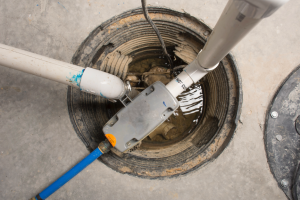 A sump pump is a vital component of any home’s waterproofing system. It is typically installed in the basement or crawl space and helps prevent water damage by removing excess water that accumulates in the sump pit. The sump pump activates automatically when water reaches a certain level, pumping it out and away from your home’s foundation.
A sump pump is a vital component of any home’s waterproofing system. It is typically installed in the basement or crawl space and helps prevent water damage by removing excess water that accumulates in the sump pit. The sump pump activates automatically when water reaches a certain level, pumping it out and away from your home’s foundation.
If you live in an area with a high water table, or an area that is prone to heavy rainfall, a sump pump is essential for protecting your home from water infiltration. Without a sump pump, your basement or crawl space could become susceptible to flooding, leading to costly water damage, mold growth, and structural issues.
Are you wondering whether you should consider installing a sump pump in your home? This sump pump installer in Riverwoods, Illinois is going to review some of the most common signs that you should below.
Signs that you may need a sump pump
- Frequent basement flooding: If your basement experiences frequent flooding during heavy rainstorms, it is a clear indication that you could benefit from installing a sump pump. A sump pump will help keep your basement dry and prevent water damage to your belongings and foundation.
- Musty odors: If you notice a musty smell in your basement or crawl space, it could be a sign of excess moisture. This moisture can lead to mold growth, which not only damages your property, but also poses health risks to you and your family.
- Visible cracks: Cracks in your basement walls or floor can indicate water seepage. A sump pump can help alleviate the pressure that causes these cracks and prevent further damage.
- Pooling water: If you notice standing water or puddles in your basement after rainfall, it is a clear indication that you need a sump pump. Ignoring this can lead to significant water damage and costly repairs.
The installation process of a sump pump
The installation process of a sump pump involves several steps to ensure its proper functioning:
- Assessment: A professional sump pump installer in Riverwoods, Illinois will first assess your home’s specific needs, considering factors such as the water table level, basement size, and potential water sources. This assessment will help determine the right sump pump size and type for your property.
- Sump pit excavation: The installer will excavate a pit in your basement or crawl space to accommodate the sump pump. The pit is typically located in the lowest part of the area to collect water effectively.
- Sump pump installation: The sump pump will be installed in the sump pit, along with a check valve to prevent backflow. Additionally, a discharge pipe will be connected to the pump to direct the pumped water away from the foundation.
- Electrical connections: The installer will ensure that the sump pump is correctly wired to an electrical outlet. In some cases, a battery backup system may be installed to ensure the sump pump continues functioning during power outages.
- Testing and final adjustments: Once the installation is complete, the installer will test the sump pump to ensure it activates properly and effectively removes water from the sump pit. They will also make any necessary adjustments to optimize its performance.
Common problems with sump pumps and how to troubleshoot them
While sump pumps are reliable, they can encounter issues that require troubleshooting. Here are some common problems and their solutions:
- Sump pump failure: If your sump pump fails to activate, it could be due to a power outage, a stuck float switch, or a faulty motor. Check the power supply, ensure the float switch moves freely, and consider contacting a professional sump pump installer for motor repairs or replacements.
- Pump cycling too frequently: If your sump pump cycles on and off too frequently, it may indicate that the pump is too small for your needs or that the float switch is set incorrectly. You can always consult with a professional sump pump installer in Riverwoods, Illinois to determine the appropriate pump size or adjust the float switch.
- Loud or unusual noises: Unusual noises such as grinding or rattling can indicate a problem with the sump pump motor or impeller. Turn off the pump immediately and contact a professional for inspection and repairs.
- Clogged discharge pipe: A clogged discharge pipe can prevent the sump pump from effectively removing water. Inspect the pipe for any obstructions and clear them if necessary. If the problem persists, seek assistance from a professional installer.
Looking for a Sump Pump Installer in Riverwoods, Illinois?
Have you noticed any signs that your home may need a sump pump? Ready to schedule a consultation with the best sump pump installer in Riverwoods, Illinois? If so, our experts at John J. Cahill Plumbing, Heating & Air Conditioning are the people to call. We can determine whether a sump pump is right for your home, and if it is, we can make sure it’s installed correctly.
Contact us today at (847) 864-5225 to begin the process.





